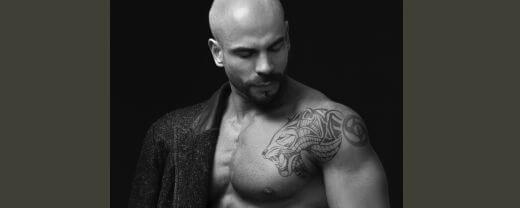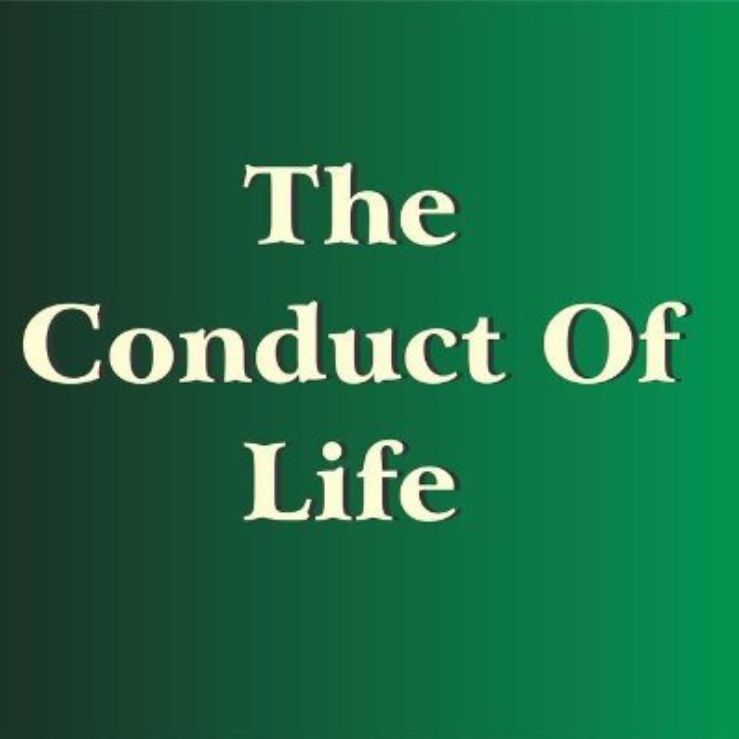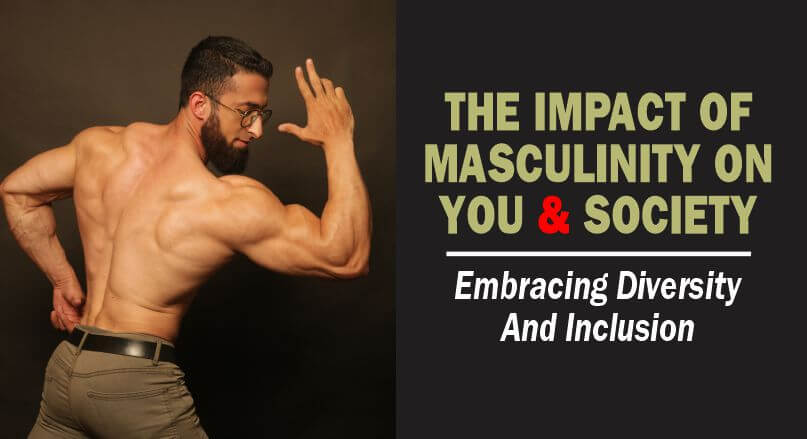Last updated on October 9th, 2023 at 07:57 am
Discover the profound impact of masculinity on society and the importance of embracing diversity and inclusion notwithstanding the changing social dynamics.
Ideas about what it means to be a man are prevalent in every society according to the norms, but there are general characteristics of masculinity that seem to be universal.
While most are healthy ways of expressing manliness, the majority are toxic and harmful to the individual and society.
Discussing masculinity is crucial for understanding gender roles, promoting gender equality, addressing harmful behaviors, fostering healthy relationships, and promoting personal growth.
We have distilled the big subject of masculinity into this article – what it is, its historical perspective, its characteristics, and how it affects society.
Table of Contents
- Definition of Masculinity
- Historical Perspective of Masculinity
- Changes In Masculinity Over the Years
- Gender Roles and Masculinity
- Characteristics of Masculinity
- Issues Men Face Around Masculinity
- Impact of Masculinity on Society
- Changing Perceptions of Masculinity
- Conclusion
Definition of Masculinity
Masculinity is the set of social and cultural characteristics or qualities typically associated with men and boys.
These may include physical strength, aggression, assertiveness, self-confidence, independence, and risk-taking, among others.
Related: The Red Flags: 12 Big Signs Of Toxic Masculinity
Masculinity is often contrasted with femininity, which typically describes traits that are traditionally associated with women, such as empathy, nurturing, and emotional expression.
While masculinity is often seen as a natural and essential aspect of male identity, its precise definition and significance can vary widely among different cultures and historical contexts.
Contemporary debates about masculinity often focus on issues such as gender identity, sexual orientation, violence, sexism, and their impact on society.
Historical Perspective of Masculinity
The historical perspective of masculinity has been shaped by a variety of social, cultural, and political factors.
From physical strength to intellectual prowess, bravery to empathy, the qualities and expectations tied to manliness have varied widely throughout history.
As society continues to evolve, so too will our understanding of what it truly means to be a man and the impact of masculinity on society.
Changes In Masculinity Over the Years
As societal norms have evolved over time across cultures, so too have the qualities and expectations associated with masculinity.
From ancient Greek ideals to modern-day depictions in media, there is a rich historical perspective of masculinity that has taken shape.
Masculinity in Ancient Times
In ancient Greece, for example, masculinity was closely tied to physical strength and athleticism.
The ideal man was strong, competitive, and skilled in sports such as wrestling and running.
This concept is evident in the Olympic Games of ancient Greece, which were exclusively for men.
Masculinity in the Middle Ages
During the Middle Ages, chivalry and honor were key aspects of masculine identity.
Men were expected to display bravery through acts of valor and protect their honor by fighting for their beliefs.
Masculinity in the Renaissance Age
As the Renaissance ushered in the Age of Enlightenment, a new focus on intellectual pursuits emerged.
Men were expected to be cultured, educated, and well-versed in the arts and sciences.
The ideal man was perceived as a logical and rational thinker, with the ability to reason and make decisions based on sound logic.
Also Read: The History Of The Gentleman Down The Ages
Masculinity During the Industrial Revolution
During the Industrial Revolution, a shift in societal roles began to take place.
Men were expected to be providers, working long hours in factories and other labor-intensive jobs to support their families.
As a result, physical strength was once again emphasized, as men needed to be capable of performing these demanding tasks.
Masculinity in the 20th Century
In the 20th century, the concept of masculinity became closely tied to nationalism and war.
Men were expected to be brave soldiers, willing to defend their country and fight for their beliefs.
This is evident in wartime propaganda, which often portrayed soldiers as hypermasculine heroes.
Masculinity in Modern Society
However, as modern society has become more progressive, the concept of masculinity has shifted once again.
Traits such as emotional intelligence, empathy, and communication skills are now valued just as highly as physical strength or intellectual prowess.
Many men are now redefining what it means to be masculine, challenging traditional gender roles and stereotypes and the impact of masculinity on society.
Gender Roles and Masculinity
Gender roles have been a part of human society for centuries, shaping the way we think about and interact with one another.
However, as our understanding of gender and identity continues to evolve, it is becoming increasingly clear that these traditional gender roles and stereotypes are limiting and harmful to both men and women.
The Impact of Gender Roles on Masculinity
Traditional gender roles have a significant impact on how men express their masculinity.
From a young age, boys are often taught to be tough, competitive, and emotionally reserved, while girls are encouraged to be nurturing, empathetic, and cooperative.
These gender roles can be limiting and harmful, as they discourage men from expressing their emotions and seeking help when they need it.
This can lead to mental health issues such as depression and anxiety, as well as contributing to toxic behaviors such as aggression and violence including other impacts of masculinity on society.
Also Read: 5 Reasons Why Women Love Beta Males As Partners
Impact Of Societal, Cultural, and Traditional Norms on Masculinity
The impact of societal, cultural, and traditional norms on masculinity is complex and multifaceted.
While these norms can provide a sense of belonging, they can also stifle individual expression and perpetuate harmful gender roles and expectations.
It is important to critically examine these norms and strive for more inclusive and diverse expressions of manliness.
These norms can vary across cultures, religions, ethnicities, and time periods, and may promote or limit certain expressions and experiences of masculinity.
Some examples of how societal, cultural, and traditional norms can influence masculinity are:
- In many cultures, men are expected to provide for their families and be the primary breadwinners. This can create pressure for men to achieve financial success and prioritize their careers over other aspects of their lives, such as personal relationships or creative pursuits.
- In some societies, men are taught to be stoic and avoid displaying emotions or vulnerability, as it may be seen as a sign of weakness or femininity. This can lead to men suppressing their feelings and experiencing mental health issues, or struggling to connect with others in meaningful ways.
Related: The Impact Of Gender Stereotypes On Individuals
- In certain communities, masculinity is connected to physical strength, aggression, and dominance over others. This can lead to an overemphasis on competition, violence, and power dynamics, which can harm individuals and perpetuate unequal social structures.
- Conversely, some cultures embrace nurturing and emotional qualities in men and reject traditional gender roles. For example, in Sweden, men are expected to take paternity leave and share household chores equally with their partners. This can challenge traditional notions of masculinity and promote greater gender equality.
- Finally, cultural and societal norms surrounding sexuality and gender identity can influence how masculinity is defined and experienced. For instance, in some cultures, homosexuality or gender nonconformity may be stigmatized and seen as unmanly or deviant. This can lead to discrimination, harassment, and violence against LGBTQ+ individuals and reinforce harmful gender stereotypes.

Characteristics of Masculinity
While the idea of masculinity varies across different cultures and communities, there are some characteristics that are commonly associated with it.
1. Physical Strength and Endurance
One of the most common traits of masculinity is physical strength.
This is often linked to the ability to protect and provide for oneself and one’s family.
Men who are physically fit, strong and muscular are typically considered more masculine than those who are not.
Such physical attributes have been glorified in popular culture and are often portrayed as the epitome of masculinity.
2. Emotional Control
Another characteristic of masculinity is the ability to control one’s emotions.
Men are typically encouraged to be calm and collected, even under stressful circumstances.
The notion that men should always be tough and not let emotions affect them, is often propagated in society.
This is based on the belief that emotions are a sign of weakness and can make a man appear vulnerable.
Also Read: Building A Strong Family: How To Be A Real Man At Home
3. Assertiveness
Men are often expected to be assertive and decisive in their actions.
This is closely related to leadership, dominance, and the ability to make decisive decisions.
Assertiveness is often considered a key trait in the workplace and in leadership positions.
In many cultures, assertiveness is regarded as a sign of strength and masculinity, and not being assertive is considered a weakness.
4. Independence
Men who are independent and self-sufficient are considered more masculine.
This is because being able to take care of oneself and not rely on anyone else is a sign of strength and resilience.
Men who are independent are perceived as being more capable of handling difficult situations and being successful in life.
5. Aggressiveness
Aggressiveness is another trait that is often linked to masculinity.
This is based on the belief that men have to be competitive, assertive and dominant, especially in situations that require physical strength or risk-taking.
This has led to men being encouraged to pursue careers that are regarded as aggressive, such as sports or military operations.
6. Perseverance
As a characteristic of masculinity, men were encouraged to bear pain, and endure for it is his nature.
Perseverance was seen as an expression of strength, determination, and resilience.
It helped men to overcome adversity, persist through challenging situations, and achieve their goals.
Related: How To Be A Real Man In The Workplace
Issues Men Face Around Masculinity
However, this strict adherence to masculine norms may impact men negatively, leading to significant issues that need attention.
Men face numerous challenges when it comes to society’s expectations and rigid ideas about what it means to be masculine.
Breaking free of these ideals can be difficult; however, it is essential to recognize and acknowledge these issues if men are to achieve their full potential.
Here are the issues men face around masculinity:
1. Emotional Vulnerability
One such issue is the expectation that men should always remain emotionally stoic.
Expressing any form of vulnerability is considered weak and is often met with derision from peers.
This can be quite damaging, as bottling up emotions can lead to increased stress, anxiety, and depression.
It also leads to difficulties in forming healthy relationships, as partners may feel like their male partners are distant and unapproachable.
2. Toxic Masculinity
Furthermore, there are several stereotypes around masculinity that are incredibly harmful and often lead to dangerous behavior.
For example, the belief that men should always be in control and dominant can lead to abusive behavior towards women and themselves.
Men are also more likely to be involved in violent encounters as a result of this expectation, leading to harmful consequences for everyone involved.
3. Body Image Pressure
Another issue confronting men is body image. Men are often expected to have a perfectly toned and chiseled physique, driven by media representations of an “ideal” male body type.
This can have a negative impact on their self-esteem, leading to body dysmorphia, eating disorders, and steroid abuse.
Related: 15 Most Frequently Asked Questions on Masculinity
This pressure to conform to a particular idea of masculinity is particularly problematic as it implies that anything that falls short of the traditional masculine ideal is automatically inferior.
To add to all this, the concept of masculinity is intertwined with the idea of toxic masculinity, which can lead to negative behaviors that go against the health and safety of both men and women.
Men who find themselves unable to meet the stringent expectations of society may lash out, engage in risky behavior, or abuse alcohol and drugs to numb their pain.
4. Hypermasculinity
Hypermasculinity is often associated with traditional gender roles and can lead to certain beliefs and behaviors that marginalize women and other marginalized groups.
Hypermasculine men may feel pressure to conform to societal expectations of masculinity, which can lead to anxieties related to not being “man enough” and intensify certain toxic behaviors such as homophobia, sexism, and violence.
It is an issue because it often perpetuates gender stereotypes and can contribute to harmful attitudes and actions towards marginalized communities.
5. Stigmatization of Men’s Mental Health
Stigmatization of men’s mental health is an issue men face around masculinity because there is a societal expectation that men should be strong, stoic, and unemotional.
This expectation can prevent men from seeking help for mental health issues because they may feel ashamed, embarrassed, or viewed as weak.
Men may also fear being labeled as “crazy” or “unstable” if they disclose their mental health struggles.
The stigma surrounding men’s mental health can be damaging, as it may prevent men from getting the care they need and can worsen their mental health issues.
It is important to recognize and challenge this stigma, promote help-seeking behaviors among men, and encourage them to prioritize their mental health.
Related: The Red Flags: 12 Big Signs Of Toxic Masculinity

Impact of Masculinity on Society
The impact of masculinity on society is multifaceted and can be seen in various aspects of our lives.
Here are some examples:
Gender Roles
Masculinity has traditionally been associated with dominance and power, while femininity has been associated with submissiveness and nurturing.
These gender roles can influence how men and women interact with one another, as well as how they view themselves and their place in society.
It also affects how men view their roles within relationships.
Some men may feel pressure to provide for their families, while others believe that it is important to prioritize their careers over their personal life.
These beliefs can lead to conflicts in relationships when they are not aligned with the partner’s expectations and needs.
It is important to note that masculinity is not inherently harmful to relationships.
However, rigid expectations and toxic beliefs about what it means to be a man can cause harm to both the individual and the relationship.
Politics and Economics
Masculinity can also have an impact on politics and economics.
For example, men are often overrepresented in positions of power and influence, such as in government and business.
This can lead to policies and practices that favor men over women, perpetuating gender inequality.
Related; The Enduring Appeal Of Beta Male Traits And Characteristics
Mental Health and Well-Being
Masculinity can also have an impact on mental health and well-being.
Traditional masculine traits such as emotional restraint and stoicism can discourage men from seeking help when they need it, leading to mental health issues such as depression and anxiety.
Additionally, toxic expressions of masculinity, such as aggression and violence, can contribute to mental health issues and harm both men and women.
Relationships
One of the most significant effects of masculinity is how it can impact relationships.
Masculinity affects relationships in many ways, both positive and negative.
Men have traditionally been expected to display certain masculine traits such as strength, assertiveness, and dominance, which can influence how they interact with their partners.
Power Dynamics
Men who are comfortable with being vulnerable and emotional are more likely to have healthy and fulfilling relationships.
Men who feel the need to control or dominate their partners can create unhealthy power play, and tension and undermine the foundations of the relationship.
For example, some men may feel the need to demonstrate their dominance by controlling their partner’s behaviors or decision-making, which can create tension and undermine the foundations of the relationship.
On the other hand, men who are comfortable with showing their vulnerable side and embracing emotions are more likely to have healthy and fulfilling relationships.
Related; The Unspoken Struggles Of Beta Males And How They Can Overcome
Communication
When men feel free to express their feelings, communicate openly, and show empathy, they strengthen the bond with their partner and create a more intimate relationship.
But those who are distant and bottle their feelings have problems both mentally and with their relationships.
No partner wants to have a man who endangers their life because they want to be a man.
Intimacy
Intimacy is another area of relationship masculinity encounters a problem. For example, in sexual performance, traditional masculinity often emphasizes sexual prowess, which can create pressure for men to constantly perform and satisfy their partners.
This can also put a strain on the relationship if one partner feels like they are not being fulfilled.
It is essential for men to challenge these outdated stereotypes and embrace a more progressive and inclusive definition of what it means to be a man.
Parenting
Traditional masculinity often emphasizes the importance of being a provider and a protector.
Men who adhere to these traditional views of masculinity may prioritize their work and career over their roles as parents.
They may also view disciplining their children as their sole responsibility while leaving the care-taking and nurturing to their partner.
This view of parenting can result in a lack of emotional connection and communication between fathers and their children, as well as a lack of involvement in their daily lives.
Children may feel neglected or unimportant, and this can have long-term effects on their emotional and social development.
Toxic Masculinity
Toxic masculinity refers to a set of behaviors and attitudes that are harmful to both men and women.
These behaviors and attitudes are often associated with traditional masculine traits such as aggression, dominance, and emotional restraint. Toxic masculinity can manifest in a variety of ways, including:
- Aggression and Violence: Toxic masculinity can lead to aggressive and violent behavior, both towards others and towards oneself. This can include physical violence, verbal abuse, and self-harm.
- Misogyny and Sexism: Toxic masculinity can also contribute to misogyny and sexism, as men may view women as inferior or objectify them. This can lead to harmful behaviors such as sexual harassment and assault.
- Emotional Suppression: Toxic masculinity can discourage men from expressing their emotions or seeking help when they need it. This can lead to mental health issues such as depression and anxiety, as well as contributing to harmful behaviors such as substance abuse.
- Homophobia and Transphobia: Toxic masculinity can also contribute to homophobia and transphobia, as men may view homosexuality or transgender identity as a threat to traditional gender roles and masculinity.
See a comprehensive article on harmful masculinity.
It is important to note that toxic masculinity is not inherent to masculinity itself, but rather a harmful expression of it.
By promoting healthy and positive expressions of masculinity, such as emotional intelligence and empathy, we can combat toxic masculinity and create a more equitable and inclusive society for all.

Changing Perceptions of Masculinity
Men’s changing perceptions of masculinity are not only essential for men but for society as a whole.
By breaking free from rigid societal norms that promote masculinity’s toxic traits, men can foster better relationships, live healthier lives, and create a society where everyone is respected and valued irrespective of their gender.
Changing perceptions of masculinity will not happen overnight, nor will it be easy, but it will surely lead to better results like breaking down the gender stereotype and encouraging both women’s and men’s emotional and psychological health.
Here are ways how we see masculinity changing before our eyes:
Positive Masculinity
Positive masculinity refers to a way of understanding and expressing masculinity that emphasizes positive traits and behaviors such as respect, responsibility, empathy, and emotional intelligence.
This approach to masculinity recognizes that being male is not synonymous with aggression, dominance, or suppressing emotions.
Instead, positive masculinity encourages men to embrace their vulnerability, communicate effectively, and take care of themselves and others.
Related: What is Healthy and Positive Masculinity? Traits And How To Practice It?
Positive masculinity aims to address the negative aspects of traditional masculinity, such as toxic masculinity, which can lead to harmful behaviors and attitudes towards women and other marginalized groups.
It recognizes that men play an important role in fostering a more inclusive and equitable society and that being strong and assertive does not have to come at the expense of being kind and respectful.
Embracing Vulnerability and Emotional Intelligence
Men who embrace vulnerability and emotional intelligence understand that it is okay to show emotions and seek support when needed, rather than stuffing down their feelings or struggling silently.
They also recognize the importance of developing emotional intelligence – the ability to identify and manage one’s own emotions, as well as understand and respond appropriately to the emotions of others.
This new way of perceiving masculinity allows men to connect more deeply with themselves and others, and to live more fulfilling and authentic lives.
It also helps to break down harmful stereotypes and expectations that can lead to toxic masculinity and negative mental health outcomes.
Also Read; Sigma Male Vs Alpha Male: Who Wins In The Game Of Life?
Dismantling Stigmatising Ideas about Masculinity
Dismantling stigmatizing ideas about masculinity is a new way of perceiving masculinity.
It emphasizes the need to break down harmful and rigid stereotypes about what it means to be a man.
This approach recognizes that traditional notions of masculinity and manhood have been influenced by social and cultural factors.
These factors tend to reinforce toxic ideas about gender roles, behaviors, and expectations.
Instead, this new approach seeks to promote a more holistic and inclusive understanding of masculinity.
This understanding emphasizes the diversity of experiences, needs, and expressions that exist among men.
It promotes the idea that there are multiple ways of being a man and that men should be free to express themselves in ways that are authentic, healthy, and respectful.
At its core, dismantling stigmatizing ideas about masculinity seeks to create a world in which men are able to explore their emotions, communicate openly, and engage in respectful and empathetic relationships with others.
It recognizes that traditional notions of masculinity have often been associated with aggression, dominance, and emotional repression, and seeks to challenge these harmful associations by promoting a more positive and empowering vision of what manliness means.
Respectful Intersectionality
Respectful intersectionality is the recognition and understanding that individuals have multiple identities and experiences that intersect and influence their lives.
This includes factors such as gender, race, class, religion, sexuality, and more.
When applied to masculinity, respectful intersectionality acknowledges that men have diverse identities and experiences that can shape their understanding and expression of masculinity.
For example, a black man may experience racism and discrimination that affects his masculinity differently than a white man, while a queer man may face stigma and marginalization in both his gender and sexuality.
By considering and respecting these multiple identities and experiences, individuals can work towards a more inclusive and equitable understanding of masculinity that recognizes and values diverse expressions of gender.
This approach encourages men to embrace their individual experiences and identities, while also rejecting harmful stereotypes and expectations that may be reinforced by traditional notions of masculinity.
Conclusion
The impact of masculinity on society is multifaceted, influencing everything from gender roles and relationships to politics and economics.
Masculinity is not an inherent trait, but rather a set of behaviors and characteristics that are socially constructed and enforced.
While traditional definitions of masculinity have been associated with physical strength, emotional stoicism, and dominance over women, more contemporary understandings of masculinity emphasize vulnerability, emotional intelligence, and empathy.
Recognizing the socially constructed nature of masculinity can help us challenge harmful gender norms and create a more inclusive and equitable society where individuals of all genders can express themselves authentically and without fear of judgment or discrimination.
As we continue to explore and challenge traditional notions of masculinity, it is important to recognize the diversity of experiences and perspectives within this complex and dynamic concept.
By promoting healthy and positive expressions of masculinity, we can create a more equitable and inclusive society for all.
Frequently Asked Questions About Masculinity
Certainly, here are some frequently asked questions about masculinity and their answers:
How is masculinity different from femininity?
A: Masculinity and femininity are often seen as opposite ends of a spectrum, with masculinity being associated with traits such as strength, assertiveness, and independence, while femininity is associated with traits such as nurturing, empathy, and sensitivity.
Is masculinity a social construct?
A: Yes, masculinity is largely a social construct, meaning that it is shaped by cultural and societal norms and expectations. While some aspects of masculinity may be influenced by biology, such as physical strength, many of the traits and behaviors associated with masculinity are learned and reinforced through socialization.
Can masculinity be toxic?
A: Yes, toxic masculinity refers to a set of behaviors and attitudes that are harmful to both men and women, such as aggression, violence, and sexism. Toxic masculinity can also contribute to mental health issues, such as depression and anxiety.
How does masculinity affect mental health?
A: Masculinity can have both positive and negative effects on mental health. On the one hand, traits such as resilience and self-reliance can be beneficial for mental health. On the other hand, toxic masculinity can contribute to mental health issues such as depression, anxiety, and substance abuse.
Can masculinity be redefined?
A: Yes, masculinity is not a fixed concept and can be redefined and expanded to include a wider range of traits and behaviors. By promoting positive expressions of masculinity, such as emotional intelligence and empathy, we can create a more inclusive and equitable society for all.
How can we promote healthy expressions of masculinity?
A: We can promote healthy expressions of masculinity by challenging traditional gender roles and stereotypes, encouraging emotional intelligence and empathy, and promoting positive role models who embody healthy expressions of masculinity.
REFERENCE
- The State of Masculinity Now: A GQ Survey
- It’s a Man’s World: The Effect of Traditional Masculinity on Gender Equality
- How Toxic Masculinity Harms Men and Society As A Whole
Pyo Merez (PsyD) is a distinguished adolescent and adult psychologist at the forefront of mental health advocacy.
With expertise in cognitive and developmental psychology, focusing on social relationships, cultural contexts, and individual differences, Pyo has dedicated his career to empowering adolescents and adults.
As a sought-after speaker and panelist, Pyo shares invaluable insights on issues affecting young people, contributing to a deeper understanding of mental health and well-being in today's society.



Wow! I love this post! As a single mom, raising boys (teen + preteen), I think this would be good to read with them also
Sure! They will grow up to have a balanced view of gender and societal expectations.
Thank you for the detailed explanation. It is very important to understand.
You are welcome Melissa.
Very interesting post, and makes me think. I work in a predominantly male work-place and when I started twenty years ago, there was unspoken pressure for females to take on more masculine traits to be a successful leader. I don’t feel that quite so much these days and the men I work with today are more respectful towards women than the men I worked for twenty years ago.
Gloria, I am happy you found this article interesting. Men are coming to the consciousness that it’s not all about being strong and stoic. Sometimes vulnerability is all they need. It’s good the men around you are keying in.